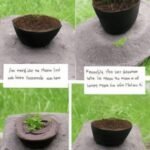lajeep
New member
Peat pots are a popular seed-starting option for gardeners. They offer several benefits, from keeping seedlings warm to reducing transplant shock.

The first step in making peat pots is to soak them. This is done by pouring an inch or so of water over the pots and letting them sit for an hour. The water will help them swell, and they should have a dark, hued color after this time.
Next, place the peat pots in a tray or other container with a dome on top to keep them humid and protected. This will also provide a few degrees of heat to the seeds and help them germinate quicker.
After you fill the pots with potting mix, place the seeds in the center. This will help the seeds sprout faster and prevent them from becoming crowded in the pot. Once the seeds have sprouted, plant them.
When the seeds have sprouted, they should be about three inches tall. To prevent rot, use a sharp knife to cut the bottom of the pot so that it is loose enough to accommodate the roots of the seedlings.
Once the seedlings have a set of true leaves, you can take them out of their starter pots and move them to a larger container or outdoor planter. You can keep them in their new containers for about two weeks, then move them to a sunny location.
If you want to save some money while also saving the environment, make your own peat pots. These can be made from a variety of materials, including newspaper strips, toilet paper or coffee filters, and even cardboard tubes.
The main problem with this method is that the materials will not decompose quickly, which can cause mold to form. If this happens, you can spray the peat pots with a 20:1 water-H2O2 mixture to kill the mold, according to Plant Care Today.
To make your own peat pots, you’ll need: a cardboard tube (a toilet paper or paper towel roll is perfect), a lid, and some peat moss. To make the peat moss, mix it with some compost, soil, and sand.
Another way to make your own peat pots is by using pressed peat strips in a seedling tray. You can cut these into sections to create rows in your tray and make it easier to separate the pieces when transplanting.
You can also purchase peat pellets and plant these in the tray as well. The pellets are made from biodegradable net and contain a layer of peat within them that will break down and allow the roots to grow into the surrounding soil.
Transplanting these peat pots is a simple process. Simply insert the peat pot in the hole in the seedling tray, cover it with some soil, and plant it into the ground. The peat will then break down and the pellets will fall out of the hole as the roots grow into the soil around them.

The first step in making peat pots is to soak them. This is done by pouring an inch or so of water over the pots and letting them sit for an hour. The water will help them swell, and they should have a dark, hued color after this time.
Next, place the peat pots in a tray or other container with a dome on top to keep them humid and protected. This will also provide a few degrees of heat to the seeds and help them germinate quicker.
After you fill the pots with potting mix, place the seeds in the center. This will help the seeds sprout faster and prevent them from becoming crowded in the pot. Once the seeds have sprouted, plant them.
When the seeds have sprouted, they should be about three inches tall. To prevent rot, use a sharp knife to cut the bottom of the pot so that it is loose enough to accommodate the roots of the seedlings.
Once the seedlings have a set of true leaves, you can take them out of their starter pots and move them to a larger container or outdoor planter. You can keep them in their new containers for about two weeks, then move them to a sunny location.
If you want to save some money while also saving the environment, make your own peat pots. These can be made from a variety of materials, including newspaper strips, toilet paper or coffee filters, and even cardboard tubes.
The main problem with this method is that the materials will not decompose quickly, which can cause mold to form. If this happens, you can spray the peat pots with a 20:1 water-H2O2 mixture to kill the mold, according to Plant Care Today.
To make your own peat pots, you’ll need: a cardboard tube (a toilet paper or paper towel roll is perfect), a lid, and some peat moss. To make the peat moss, mix it with some compost, soil, and sand.
Another way to make your own peat pots is by using pressed peat strips in a seedling tray. You can cut these into sections to create rows in your tray and make it easier to separate the pieces when transplanting.
You can also purchase peat pellets and plant these in the tray as well. The pellets are made from biodegradable net and contain a layer of peat within them that will break down and allow the roots to grow into the surrounding soil.
Transplanting these peat pots is a simple process. Simply insert the peat pot in the hole in the seedling tray, cover it with some soil, and plant it into the ground. The peat will then break down and the pellets will fall out of the hole as the roots grow into the soil around them.
